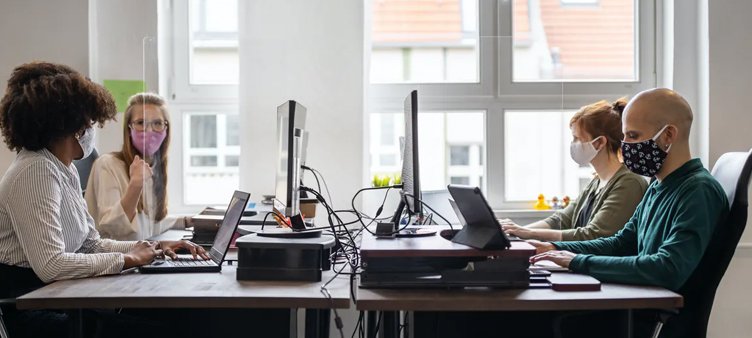
Following months and months of being stuck at home and staying well away from the office, some of us are now returned, and for many of those that haven’t and are still based out of spare bedrooms, kitchens, and slap-up home offices, the prospect of returning is well and truly on the horizon, even in the wake of the second wave and the return of restrictions.
However, the work environment we’re all returning to—especially office-based work environments— is a world away from the ones we left and were used to. Social distancing guidelines are still in place and office managers are having to pivot their entire set-up in an attempt to try and safely accommodate staff and devise something that’s at the very least functional.
When you do eventually return to the office, you’ll still have to wear masks, have daily temperature checks, and perhaps even have to fill out health questionnaires. For some people, you might not even be back full-time. But even with all these changes, there are still plenty of risks, and there are certain areas in the office that pose a greater risk than others.
So, whether you’re an office user, a team leader, or an office manager, take note—this information is highly relevant!
Although it sounds scary, experts think (and they’re probably right!) that a single infected surface in an office could spread the virus everywhere else. And if you think about it, this makes sense. We know that COVID-19 is a highly infectious droplet infection and spreads much easier than other viruses and diseases such as the norovirus.
All it takes is for one infected person to cough, sneeze, or touch a surface and that’s it. The virus can live there and multiply for days on end if the conditions are just right, and anyone who touches that surface will more than likely carry the virus and begin spreading it to other surfaces. Before you know it, the office is teeming with the virus and everyone’s at risk.
That’s exactly why you need to get clued up on the office-related COVID-19 risks, particularly the areas you need to pay special attention to and be extra cautious about.
By now, we should all be well aware that the virus spreads more easily indoors, especially in confined spaces. Unfortunately, confined spaces are inherent in office spaces. Think about how much time in a week you spend in the lift moving from floor to floor, in meeting rooms (usually being bored to death!), and in bathrooms. It’s a lot, right?
To prevent the spread of the virus, employees should avoid them as much as possible. Meetings should still be held virtually where possible, employees should be encouraged to avoid lifts and take the stairs (but still, stairs are fairly confined), and employers should be placing additional hygiene solutions in bathrooms, such as sanitiser dispensers and guidance posters.
Go back a year and the wearing of face masks when you go to use the toilet would have been unimaginable. Now, however, it’s advisable if you want to limit your exposure to coronavirus as much as you possibly can. That’s because toilet cubicles are breeding grounds for bacteria, pathogens, disease, and viruses.
A lot of people are blissfully unaware of what goes on when a toilet is flushed with the lid open. When this is done, tiny particles are thrown up into the air—sometimes as high as one metre from the toilet bowl—and can contaminate the air around the cubicle. If someone with COVID-19 has recently used the toilet, particles infected with the virus can enter your respiratory tract and infect you, too. So, close the lid when you flush.
That’s not the only risk in toilet cubicles, though. All touchpoints are potential vectors for infection, so it should go without saying that if you use a toilet cubicle—or indeed any type of restroom facility—that you thoroughly wash your hands afterward!
Shared kitchens, kitchenettes, and break rooms are one of the most high-touch areas in an office environment. You may only be in there for a few seconds or a matter of minutes to make a tea or coffee, but the chances are that you have touched a number of different surfaces.
From the simple act of making a tea or coffee, some of the touchpoints you’ll use may include coffee machines, kettles, buttons, taps, fridges, microwaves, shared cutlery, drawers, cupboards, sugar pots, and milk bottles, just to name a few.
Everyone using shared spaces like kitchenettes should be taking personal responsibility when they do so by cleaning up after themselves, disinfecting surfaces and touchpoints, and washing their hands. Employers and office managers should also look into enhanced and more frequent cleaning of these areas.
Although this seems like the most obvious of all COVID hotspots, it’s also the most dangerous. You’d be surprised and probably disgusted at how many people don’t wash their hands after they’ve touched door handles.
It’s a good idea to get into the habit of washing your hands after you’ve been travelling around the office because, let’s face it, there’s no avoiding door handles in most office buildings and you can’t really trust other people to keep their hands clean. If you’d like to avoid touching door handles altogether, it might be worth investing in handle hooks that can be used to push and pull doors. These can usually be attached to your keys for extra convenience.
All office users—both employees and employers—have a role to play in keeping the office environment safe and “COVID-secure”.
Employees need to try as hard as they can to follow not only government guidelines but also guidelines and rules put in place especially for the office environment, such as physical distancing, virtual meetings wherever possible, and no mixing of different teams. Employees should also continue to wear masks when they’re away from their desks.
As for employers, they must take reasonable steps to protect their workers from COVID-19. In addition to setting guidelines, employers should invest in suitable office hygiene solutions such as hand sanitiser dispensers, additional and enhanced cleaning regimes, and extra staff training. It’s also important to promote regular handwashing and hand sanitising. Use signs and posters to help your workers practice good hand washing techniques and provide lots of opportunities for workers to sanitise their hands by using these hand sanitizer dispensers.
If you manage an office or operate any other sort of workplace environment, it’s absolutely crucial that you follow the official COVID-19 guidance as issued by the governments and authorities such as the Public Health Authority and Health and Safety Executive.
A huge part of ensuring compliance is hand hygiene, and that’s why we provide a large range of hand hygiene products ideal for the workspace, no matter if it’s an office, shop, or restaurant.
Read our blog for more resources or visit our online shop.
Emir Limam – E11 Group B.V. Netherlands – Fraudster
24 May 2023When to Take a Test After Covid Exposure?
30 January 2023A Rapid Antigen Test vs a Lateral Flow Test for Covid-19
30 January 2023